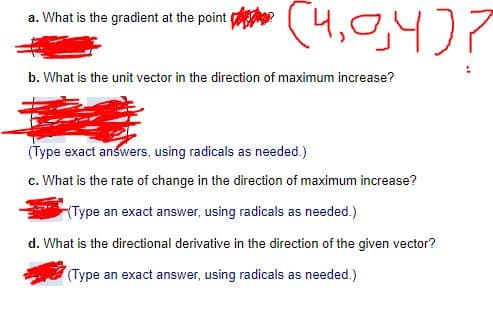Consider the function f(x.y.z) =x + 2y? + 3z? +2, the point P(4,0,4), and the unit vector u = a. Compute the gradient of f and evaluate it at P. b. Find the unit vector in the direction of maximum increase of f at P. c. Find the rate of change of the function in the direction of maximum increase at P. d. Find the directional derivative at P in the direction of the given vector.
Consider the function f(x.y.z) =x + 2y? + 3z? +2, the point P(4,0,4), and the unit vector u = a. Compute the gradient of f and evaluate it at P. b. Find the unit vector in the direction of maximum increase of f at P. c. Find the rate of change of the function in the direction of maximum increase at P. d. Find the directional derivative at P in the direction of the given vector.
Calculus: Early Transcendentals
8th Edition
ISBN:9781285741550
Author:James Stewart
Publisher:James Stewart
Chapter1: Functions And Models
Section: Chapter Questions
Problem 1RCC: (a) What is a function? What are its domain and range? (b) What is the graph of a function? (c) How...
Related questions
Question
q21

Transcribed Image Text:Consider the function f(x.y.z) =x +2y + 3z + 2, the point P(4,0,4), and the unit vector u =
a. Compute the gradient of f and evaluate it at P.
b. Find the unit vector in the direction of maximum increase off at P.
c. Find the rate of change of the function in the direction of maximum increase at P.
d. Find the directional derivative at P in the direction of the given vector.

Transcribed Image Text:(4,0,4)7
a. What is the gradient at the point
b. What is the unit vector in the direction of maximum increase?
(Type exact answers, using radicals as needed.)
c. What is the rate of change in the direction of maximum increase?
Type an exact answer, using radicals as needed.)
d. What is the directional derivative in the direction of the given vector?
(Type an exact answer, using radicals as needed.)
Expert Solution
This question has been solved!
Explore an expertly crafted, step-by-step solution for a thorough understanding of key concepts.
This is a popular solution!
Trending now
This is a popular solution!
Step by step
Solved in 4 steps with 4 images

Recommended textbooks for you

Calculus: Early Transcendentals
Calculus
ISBN:
9781285741550
Author:
James Stewart
Publisher:
Cengage Learning

Thomas' Calculus (14th Edition)
Calculus
ISBN:
9780134438986
Author:
Joel R. Hass, Christopher E. Heil, Maurice D. Weir
Publisher:
PEARSON

Calculus: Early Transcendentals (3rd Edition)
Calculus
ISBN:
9780134763644
Author:
William L. Briggs, Lyle Cochran, Bernard Gillett, Eric Schulz
Publisher:
PEARSON

Calculus: Early Transcendentals
Calculus
ISBN:
9781285741550
Author:
James Stewart
Publisher:
Cengage Learning

Thomas' Calculus (14th Edition)
Calculus
ISBN:
9780134438986
Author:
Joel R. Hass, Christopher E. Heil, Maurice D. Weir
Publisher:
PEARSON

Calculus: Early Transcendentals (3rd Edition)
Calculus
ISBN:
9780134763644
Author:
William L. Briggs, Lyle Cochran, Bernard Gillett, Eric Schulz
Publisher:
PEARSON

Calculus: Early Transcendentals
Calculus
ISBN:
9781319050740
Author:
Jon Rogawski, Colin Adams, Robert Franzosa
Publisher:
W. H. Freeman


Calculus: Early Transcendental Functions
Calculus
ISBN:
9781337552516
Author:
Ron Larson, Bruce H. Edwards
Publisher:
Cengage Learning